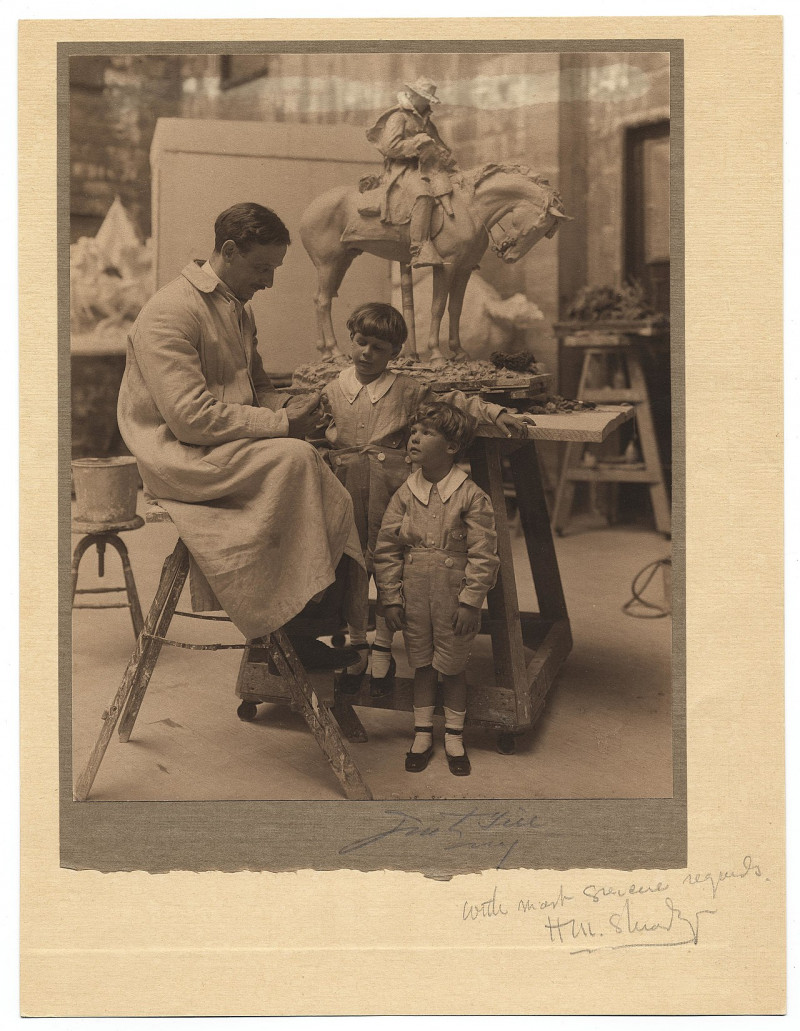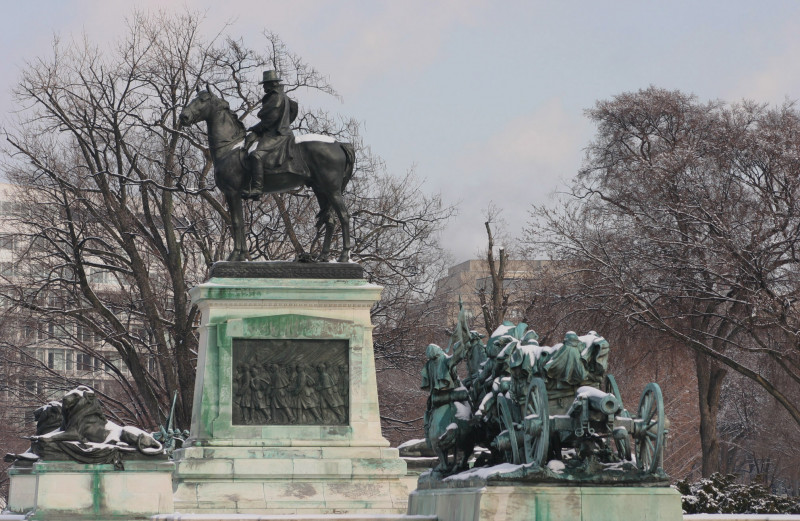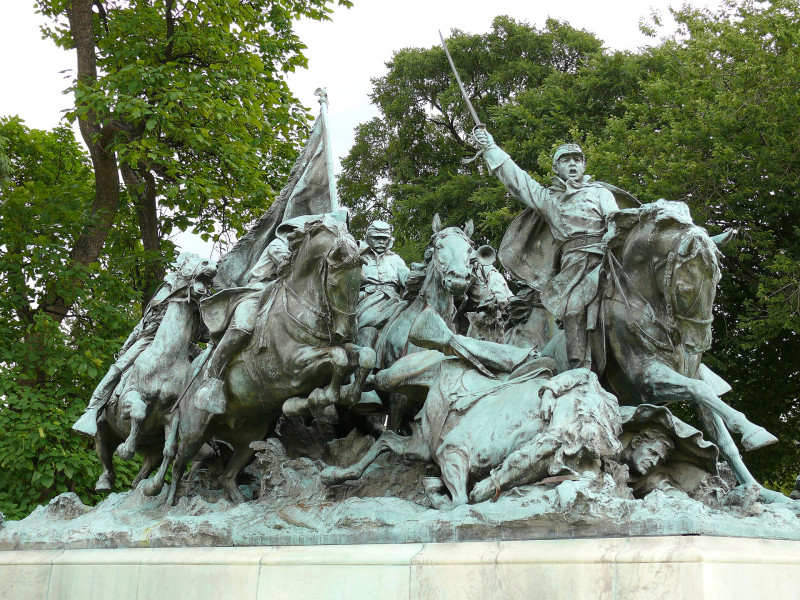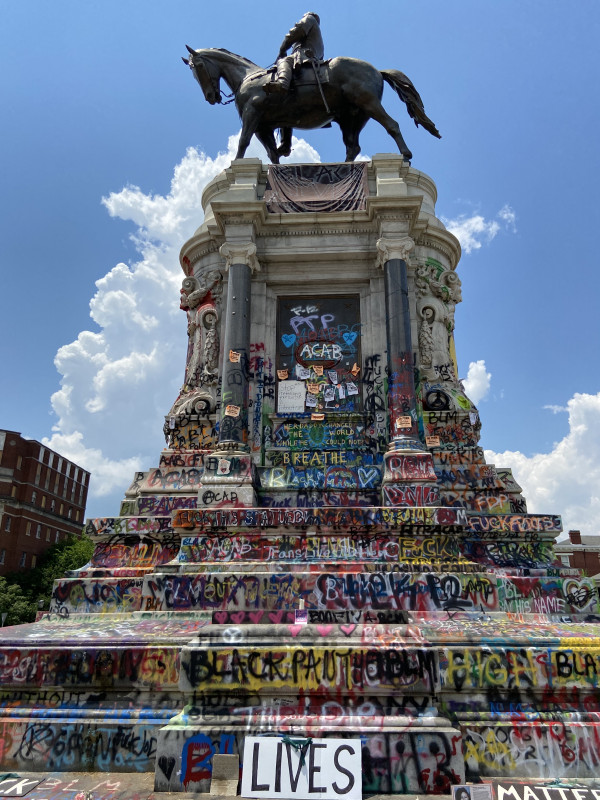A Republic If You Can Keep It: Washington, DC’s Memorial to Ulysses S. Grant
Michael C. Kimmage, 12 May 2021
Before the Capitol building in Washington, DC stands the largest equestrian statue in the United States. It depicts Ulysses S. Grant, president from 1869 to 1877 and the pivotal Northern General in the Civil War. The statue has a long history. In the 1890s, the Society of the Army of Tennessee, a group of Civil War veterans, many of whom had served under Grant, began gathering money for a memorial. Daniel Chester French and Augustus Saint Gaudens, the eminences grises of nineteenth-century American sculpture, led the committee that in 1902 selected Henry Mervis Shrady to make a statue. (Shrady was a student of Karl Bitter, who had emigrated to the United States from Austria in 1889 and excelled at neoclassical civic sculpture.) Shrady spent twenty years working on his elaborate memorial to Grant.

Shrady’s completed work is – unlike Washington DC’s Lincoln or Jefferson Memorials – largely unknown. Anything but iconic, it occupies a key spot in the capital city redesigned at the beginning of the twentieth century. The National Mall, which had become a mess of train tracks and parts of which were still swampland circa 1900, was cleared. It was made into an open expanse of green space and eventually ringed by museums and government buildings. This space tells the national story as one of unity, focalized by the Washington Monument, the enormous obelisk at the Mall’s center. It is anchored at the Eastern end by Shrady’s Grant, who had vanquished the Confederacy, and at its Western end by a memorial to Abraham Lincoln, who had saved the Union. Daniel Chester French’s famous statue of Lincoln is not equestrian. It is Lincoln seated, godlike and solemn, and to be approached in his pantheon by walking up several flights of temple steps.
That Shrady’s Grant statue is so unknown is regrettable. Shrady captured an awkward, unloved truth of American democracy. The country had split in two in 1861. The constitution had failed the people, and “we the people,” in the constitution’s first three words, had failed the constitution. One side triumphed, doing so not through persuasion but through force of arms. Only violence could deliver what the North came to want: a country loyal to the constitution and at the same time liberated from the institution of slavery. From the tragedy of this violence, the modern United States emerged. Were the National Mall home only to a Lincoln Memorial, one might think that Lincoln’s words, enshrined on the memorial walls, were enough – that Lincoln had operated by eloquence and noble sentiment alone.

Shrady knew better. In the statue before Congress (dedicated on April 27, 1922) Grant is calm and unheroic, shoulders slouched and his bearing unperturbed by the chaos unfolding all around him. To one side of a demure Grant is a statue depicting an artillery battery. On its other side is a cavalry charge. These accompanying statues are disturbingly violent. Rather than glamorizing Grant or his army, they delve – with an ambitious and frenetic realism – into the horror of war. The bronze soldiers, including Grant, all face westward, meaning that they gaze out beyond the Mall to the hills of Arlington Cemetery, a cemetery established during the Civil War on property that had once belonged to Robert E. Lee, Grant’s Southern adversary. Shrady makes no secret of struggle, suffering and death as the soul of war.

Finally, there are the lions. Four of them lie guarding the U.S. flag and the flags of the U.S. army. Lions are the typical emblems of monarchy and as such relatively uncommon in American civic architecture – unlike the eagle, the national bird, which is ubiquitous. Shrady’s lions do not represent a king. They indicate the need for vigilance and violence, the bond between nation and army that is echoed in the choice of flags. These are not sleeping lions poised to awaken at the sight of a foreign enemy. They are animal signs of the vigilance required to contend with domestic enemies and with the terrifying vulnerabilities of self-government. Shrady’s Grant statue has true intellectual depth. It is wisely cautionary rather than blandly celebratory.
The insurrection of January 6, 2021 started on the National Mall. There at the ellipse, where the Southern lawns of the White House lower into the Mall (near the Washington Monument), President Trump and others spoke their incendiary words. They lamented a stolen election and implied that the outcome was still in question. They knew that as they gathered in the late morning a vote to confirm Joe Biden as the next president was soon to be held in the U.S. Congress. President Trump urged the crowd of some ten thousand people to march on the Capitol and to “fight like hell.” The crowd followed his advice. As some among them had been planning in advance, they marched on a poorly protected building, seeking either to disrupt the vote or to install Trump as president for life, as their king, though the tangible motives of the rioters are opaque. They were seeking revenge and revenge on a diversity of enemies.
Those present on the ellipse were themselves a motley crew. Some came along for the ride and were not expecting anything more than the familiar spectacle of a Trump rally. Some were delusional, having been convinced that the Democratic Party was the real illusion and that this illusion could be made to vanish if only Trump’s followers were sufficiently vocal, active, and loyal. Some were enamored of online conspiracy theories and were reading into this rally and the march on Congress an apocalyptic step toward the realization of their dream world, the end of history at long last, pure and reactionary and tantalizingly at hand. Some were simply criminals with a keen sense for a moment at which crime could be dressed in the garb of high politics, a group present at every revolution, eager to see the guillotine fall.
A subset of this mob was historically minded. Some had come to Washington on January 6 to re-litigate the Civil War, acutely aware of what it means to have a National Mall dedicated to Northern victory. The mob was awash in nostalgia for the Confederacy. Many of its members had brought Confederate flags to the Trump rally on the ellipse and then to the Capitol. Though a New Yorker, Trump had regularly burnished the memory of the Confederacy as president, refusing, for example, to rename military bases that paid homage to Confederate Generals. Trump was a historical revisionist, the most pro-Confederate president since Woodrow Wilson, the first Southern president to be elected after the Civil War. Trump’s supporters on the Mall were voicing sentiments that he had helped them to voice and had been helping them to voice since his first presidential campaign. On January 6, that was one source of the enthusiasm for Confederate signs and symbols.
Conspicuously, a single rioter strode through the halls of Congress with a Confederate flag. It was more than a gesture, more than guerrilla theater. It was – in an age of images – a repurposing of the most important political structure in the United States. The building had not in fact been conquered, and this flag was not equivalent to the Soviet flag propagandistically waved above the Reichstag in the spring of 1945. The Confederate flag displayed in January 2021 was aspirational. It opened the possibility of an alternative future by opening the possibility of an alternative past, in which the Confederacy was no longer a synonym for defeat, no longer an object of shame and disgust, but a layer of American history on which it was still possible to build, the Civil War a detour that reveals the true path. Donald Trump is peripheral to this narrative. He is simply the man who proved that the Pandora’s box of neo-Confederate sentiment is not permanently locked.
Less noticed than the parade of the Confederate flag through the U.S. Congress was another Civil War reenactment on January 6, this one outside of the building. A group of men climbed atop the statue of Ulysses S. Grant, Shrady’s meditation on democracy and force, seemingly not by accident. They too had Confederate flags in hand. The fact that Shrady had sculpted Grant and the Union soldiers to scale – that they were life-sized – imposed a visual parity on the rioters and on bronze figures meant to remind passersby of the Civil War. Here too it was the narrative reversal that thrilled the rioters. If the South can never win the Civil War, and the North can never lose, the permanence of Northern victory can nevertheless be questioned and qualified. That was the point of placing a Confederate flag atop a representation of Ulysses Grant.

The spontaneous reworking of Civil War memory on January 6 was, on closer inspection, the second act of a larger drama. When George Floyd was murdered and waves of protest washed over the entire country, statues related to the Confederacy were a common object of redefinition. There are still many such statues in the American South, most of them erected long after the Civil War, often at the same time that Shrady was constructing his Grant Memorial and French his Abraham Lincoln statue. The more the Federal Government aligned Washington, DC with the North and with the fruits of Northern victory in 1865, the more white Southerners pushed in the opposite direction. By visually linking their civic centers to the Confederate past, they could argue for an honorable Confederacy and for continued racial segregation.
Nowhere was this impulse more extensively acted upon than in Richmond, Virginia, erstwhile capital of the Confederacy. In 1890, Monument Avenue in Richmond was conceived, a broad boulevard in the city with five separate memorials. Four were to Confederate Generals and one to the former president of the Confederacy, Jefferson Davis, a project finished in 1925. Its set-piece was an equestrian statue to Robert E. Lee, the product of the Lee Memorial Commission formed in 1886 in part by veterans who had served under Lee. Its sculptor was Antonin Mercie, an alumnus of the École des Beaux Arts in Paris, known for his memorials in France (to Jules Michelet among others) and for his lovely statue of the Marquis de Lafayette across from the White House in Washington, DC. Mercie’s Lee towers above Richmond’s Monument Avenue.
One might ask why this statue is in Richmond at all. Lee was a failure. Having led a ruinous war against the United States and a slaveholder who had his slaves tortured, Lee should be considered a traitor, a self-evident villain of American history. He was the one to surrender to Grant in April 1865. Lee’s memory poses no actual threat to the United States: his Confederacy disappeared in 1865 never to return. Yet commemorating Lee is nationally provocative because Lee’s alleged dignity mirrors the alleged dignity of the “lost cause.” His statue and others like it sketch out a transvaluation of values. In simpler language, they are an avowal of white supremacy, not simply as an aspect of the American past but as a figment of the American future.
The first act of the drama destined for its diabolical climax on January 6, 2021 occurred during the previous summer. After George Floyd’s death on May 25, the protests’ most striking image involved the statue of Robert E. Lee in Richmond, Virginia. On a summer evening, during a vigil for George Floyd, a photograph of Floyd was projected onto the tall pediment of Lee’s statue, above which was emblazoned the words “no justice no peace.” Onto Lee himself the initials BLM, meaning “black lives matter”, were superimposed. Interpretations of this improvised collage lie in the eye of the beholder. No doubt some were horrified by this twenty-first-century commentary on Lee’s legacy. For those who appreciated its translation of an old statue into new meanings, the point was clear. Lee’s white-supremacist cause was still salient. Lee was obviously still there in Richmond, his bequest the murder of George Floyd and related acts of sadism and aggression. An end to the Civil War, peace grounded in justice, had never arrived.

Some 155 years after the Civil War, the deepest fault line in American politics is not disagreement about political economy, about abortion, about the proper course of American foreign policy. It is the ancient wound. The protestors in Richmond (in the summer of 2020) and those at the Capitol in January 2021 agreed on one historical thesis: that the Civil War was not yet over. Lee’s racism has endured, a continuum of exclusion and animosity necessitating the claim that black lives matter. For those at the Capitol, the Federal Government was only partially legitimate. Its self-styled racial progressivism – witnessed in its valiant Grant and Lincoln statues – is a lie. President Trump inspired both sides. To one, he was a child of Robert E. Lee, culpable for George Floyd’s death. To the other side, he was a visionary leader urging his supporters to secede from a government (of which Trump was the nominal head on January 6) as transient in its legitimacy as the Northern heroes of the Civil War could appear when defiantly surrounded by Confederate flags.
President Biden’s instinct is to reconcile. Having grown up in Pennsylvania, he spent most of his adult life in Delaware, which like nearby Maryland is a borderland as far as the Civil War is concerned. Massachusetts was the North and Virginia the South. States like Delaware were to the North of Washington, DC. Yet in their folkways and political affiliations, they could be as Southern as they were Northern. Today, without being bastions of neo-Confederate zeal, they contain multitudes or they contain the contradictions that describe the nation at large – racism and hope for racial progress, histories of segregation and of desegregation, loyalties that point in many different directions.
Roots in Delaware may prove to be an advantage for Biden. A man of soft edges, he can try to soften the edges of national discord. For eight years, Biden had been vice president to Barack Obama, who had wanted to reconcile as well and to unify – but who modeled himself, a resident of Illinois, on Lincoln, patron saint of the North. Biden may look to models less inflammatory than Abraham Lincoln of Illinois, in search of constituencies in the North and in the South. In the 2020 election, the Northeast voted proudly for Biden, from Maine to Pennsylvania. One of the states that gave him his margin of victory, though, was the very Southern state of Georgia. That could be an omen.
Or being from in between may prove a disadvantage for Biden. Since 1861, the awful logic of the Civil War has been binary. One side wins and another side loses. If Delaware was complicated in the 1860s, it was part of the Northern war effort. If Georgia voted for Biden, almost every other former Confederate state (Virginia excepted) voted for Trump. As a politician, Trump prospered by dividing the country, by stoking anger. It is by no means a corollary of his election loss in 2020 that Biden will prosper by endeavoring to unite the country. At worst, Biden could be too Southern for the North and too Northern for the South. The longevity of Civil War divisions is an omen too.
Should Biden be unable to reconcile what for so long has been unreconciled, he can contemplate Henry Mervis Shrady’s unsentimental memorial to Ulysses Grant. Grant twice had to defend the constitutional order with force. Once was as a General, Shrady’s subject. The second time was after the war, when the North occupied the South militarily and when – until 1877, after Grant left the White House – African American men were actively voting, running for office and serving in government. The so-called first Ku Klux Klan was successfully crushed by Grant in the 1870s not through presidential speeches and written communications but with forthright coercion. Grant’s tenure as president corresponds to a period of genuine optimism and considerable violence. Its historical lessons are sobering.
Appropriately, Shrady’s Grant is at the moment inaccessible to the public. Immediately after January 6, the grounds of the Capitol were fenced off. The Capitol itself was protected by thousands upon thousands of National Guard troops. The National Mall was – for a time – fenced off as well. Downtown streets were patrolled by soldiers. A trope of journalism, in the days before Joe Biden was inaugurated on January 20, was that Washington’s city center resembled the green zone in Baghdad or the metropolitan core of other cities torn apart by war. These were the wrong analogies. The right analogy would have been to Washington, DC during America’s own Civil War, when the city was filled with soldiers and surrounded by fortifications. For four years, it was an armed camp. Then the war was over, leaving the country that had fought it condemned to live on in the bitterness of excessive historical memory.

